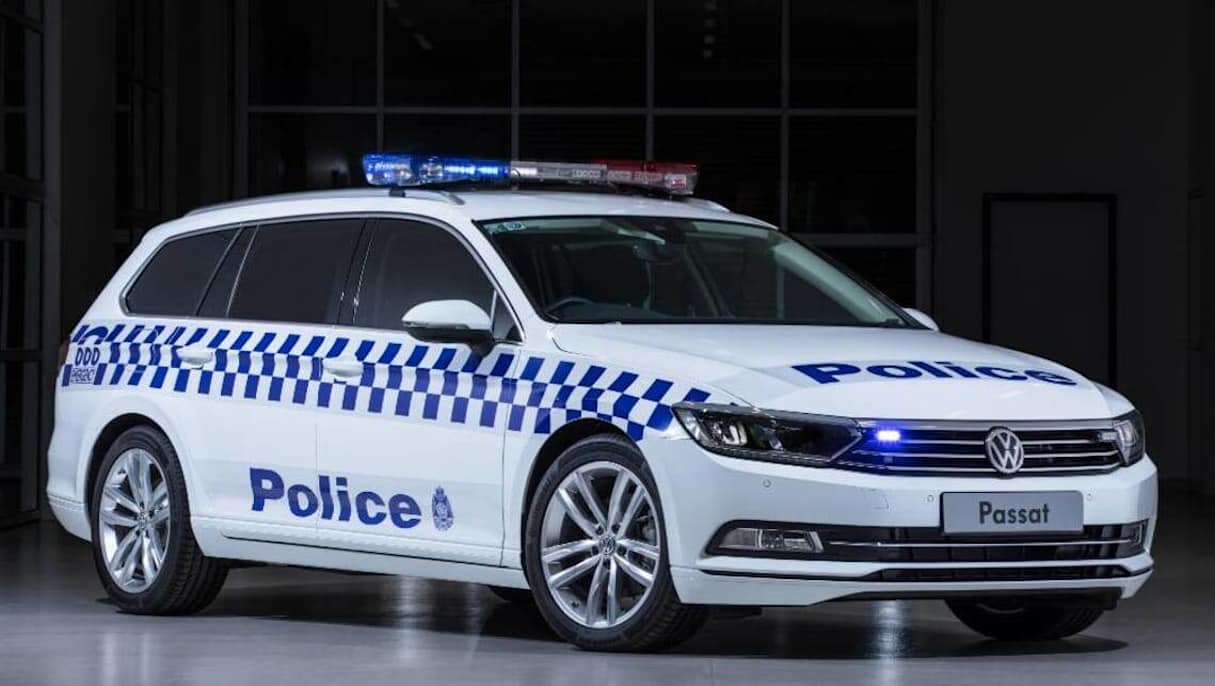As more Australian buyers transition to electric vehicles, some of Australia’s police organisations are evaluating what their future fleets will look like in an increasingly electrified world.
Following the closure of the Ford, Holden and Toyota factories, police fleets have moved to a variety of imported makes and models. Victoria and New South Wales Police use the diesel-powered BMW 530d as its highway patrol car of choice, while Kia Stingers and Chrysler 300 SRTs can be found stopping speeding drivers in some states.
Volkswagen Passats, Ford Rangers, Hyundai Sonatas and Santa Fes and Toyota Camrys are also used for general duties in different states and territories.
But as more manufacturers shift their focus to low and zero-emissions vehicles, police fleets are slowly changing too.
Some police forces have already added EVs to their fleet in limited numbers for evaluation purposes.
A Hyundai Kona Electric is being used by the Nepean Police Area Command, based in Penrith, as part of its crime prevention unit. Victoria Police added a Tesla Model X to its fleet for assessment in 2019.
While police organisations are generally pretty coy when it comes to their future vehicle fleet, a Queensland Police Services spokesperson said the force is looking to eventually add electric vehicles to its fleet.
“We are continually monitoring electric and other technology in the global vehicle market with a view to adopting into the fleet wherever operationally effective and safe to do so, and with a view to reducing carbon footprint, honouring government commitments, and lowering operating costs wherever possible,” they said.
.jpeg)
Victoria Police is also keeping a close eye on Australia’s EV rollout, according to a spokesperson.
“Victoria Police continues to work with vehicle manufacturers to evaluate electric vehicles as they are introduced to the Australian market, including their suitability to be custom-fit with police equipment that meets operational requirements.”
The spokesperson said the Tesla Model X that was introduced in 2019, and is still in service, has been critical in providing insights into how an EV will fit into the fleet longer term.
“The Tesla Model X has been invaluable for Victoria Police in testing the feasibility and identifying the infrastructure required to underpin the wider introduction of electric vehicles in the fleet.”
Hyundai Australia senior manager of future mobility and government relations Scott Nargar said the feedback from the Nepean police about the Kona Electric has been positive since it started service in January this year.
“We are getting feedback that officers love it. We haven’t had any negative feedback. They all love the power and torque. And the practicality of it. There is an AC charger in the basement of the Penrith police station where it is based,” he said.

Mr Nargar said Hyundai Australia was talking to various state and territory police organisations about its current and future EV line-up, but could not provide further details.
However, he said Hyundai EVs like the recently launched Ioniq 5 are ideal for a variety of police duties, including highway patrol.
“Looking at where Kona Electric is now, where Ioniq 5 is heading, and our competitor cars, I think EVs would be great for general duties applications. And I think, looking at the future when we get those high-performance cars, things like the Ioniq 5 would make a great highway patrol car.”
Given police cars are fitted out with electrical equipment like radars and computer systems, an EV like the Ioniq 5, which has a 3.6kW Vehicle-to-Load adaptor, would be ideal for those kinds of operations, he added.
Using EVs in trials will eventually help lead a wider take-up within police fleets, especially as manufacturers sharpen their focus on EVs, Mr Nargar said.
“I think the way these vehicles are being deployed at the moment, as in community liaison or general duty vehicles in other countries around the world, is a perfect first step as we start to evolve our transport fleet to something cleaner.
“Lots of these countries that have gone from trials to now having them deployed in their fleet as part of their standard service, are doing that because they know the choice of internal combustions is reducing and eventually they won’t have a choice of internal combustion for police service vehicles. They are seeing the practicality, the durability and the environmental benefits of having these vehicles on their fleets as well.”

Mr Nargar said it is difficult to predict when the majority of police vehicles in operation across the country will be electric, or electrified. But he added that it will be led by other big fleets making the transition.
“Some of the biggest fleets are government fleets, we are starting to see a number of fleets with their nation-leading announcements. The fleet transition will drive the change. And if you’ve got big fleets transitioning, then manufacturers understand there is a market for those vehicles in a particular country for both electric and hydrogen fuel cell, and they will start to develop vehicles for this country.”
EVs are in use in a number of European countries, albeit in small numbers. The Hyundai Kona Electric can be found on the beat in Germany, Switzerland, the Netherlands, Spain, Belgium and the UK. The Italian police force uses some Hyundai Nexo FCEVs, while a fleet of VW e-Golfs were used in Paris.
In the Unites States, the LA police department uses Teslas as a way to promote sustainability, but smaller police forces in other states have started to add EVs to their roster as a way to save money.
According to Officer.com, the Bargersville police department in Indiana added a number of Tesla Model 3 and Model Ys to its fleet after realising the long-term cost-saving benefits of EVs.
Across the ditch in New Zealand, the police force has been evaluating hybrid and electric vehicles. But a report from Stuff.co.nz quoted the force as saying that while electric and hybrid tech “does not currently align with Police’s core business requirements, EVs and hybrids will continue to be tested as the technology improves in terms of vehicle performance and range”.





.jpg)
.jpg)

.jpg)
_0.jpg)


.jpg)







.jpg)
.jpg)







